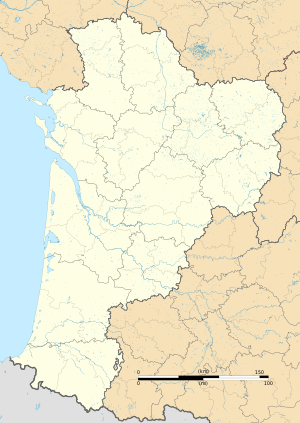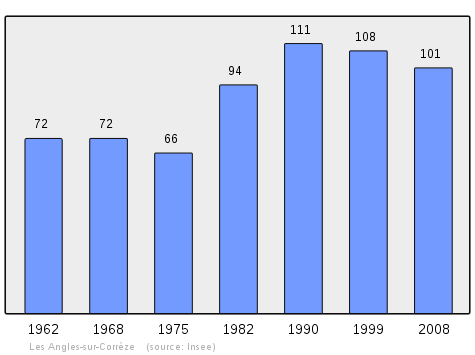Les Angles-sur-Corrèze
Les Angles-sur-Corrèze (Los Angles de Corresa in Occitan) is a commune in the Corrèze department in the Nouvelle-Aquitaine region of central France.
Les Angles-sur-Corrèze | |
|---|---|
A general view of Les Angles-sur-Corrèze | |
.svg.png) Coat of arms | |
Location of Les Angles-sur-Corrèze 
| |
 Les Angles-sur-Corrèze  Les Angles-sur-Corrèze | |
| Coordinates: 45°18′28″N 1°47′51″E | |
| Country | France |
| Region | Nouvelle-Aquitaine |
| Department | Corrèze |
| Arrondissement | Tulle |
| Canton | Naves |
| Intercommunality | Tulle et Cœur de Corrèze |
| Government | |
| • Mayor (2014–2020) | Christian Dumond |
| Area 1 | 4.73 km2 (1.83 sq mi) |
| Population (2017-01-01)[1] | 112 |
| • Density | 24/km2 (61/sq mi) |
| Time zone | UTC+01:00 (CET) |
| • Summer (DST) | UTC+02:00 (CEST) |
| INSEE/Postal code | 19009 /19000 |
| Elevation | 224–481 m (735–1,578 ft) (avg. 250 m or 820 ft) |
| 1 French Land Register data, which excludes lakes, ponds, glaciers > 1 km2 (0.386 sq mi or 247 acres) and river estuaries. | |
Geography
Les Angles-sur-Corrèze is located some 7 km north-west of Tulle and 30 km south-west of Égletons. It is traversed by the A89 autoroute from west to east through the heart of the commune but there is no exit in the commune. The nearest exits are Exit 20 to the west of the commune and Exit 21 to the east. Access to the commune is by road D58 which branches off the D23 south of the commune and continues north to the village and continues north then east to join the D1089 highway which forms the south-eastern border of the commune. There are large areas of forest in the commune with some areas of farmland near the village. Apart from the village there is the hamlet of Le Massoulier towards the east.[2]
The Corrèze river forms the northern and western borders of the commune as it flows south to join the Vézère west of Brive-la-Gaillarde. Many unnamed streams rise in the commune and flow into the Correze.[2]
Neighbouring communes and villages
Toponymy
The locality appears in charters dated 1404 in the form Anguli. Its name is a reference to the shape of the village of a pointed wedge (like the head of a wood-chopping axe).
History
Heraldry
.svg.png) Arms of Les Angles-sur-Corrèze |
Blazon: Azure, an escarbuncle of Or. |
Administration
List of Successive Mayors[3]
| From | To | Name | Party | Position |
|---|---|---|---|---|
| 2001 | 2020 | Christian Drumond |
(Not all data is known)
Demography
In 2009 the commune had 104 inhabitants. The evolution of the number of inhabitants is known through the population censuses conducted in the commune since 1793. From the 21st century, a census of communes with fewer than 10,000 inhabitants is held every five years, unlike larger towns that have a sample survey every year.[Note 1]
| 1793 | 1800 | 1806 | 1821 | 1831 | 1836 | 1841 | 1846 | 1851 |
|---|---|---|---|---|---|---|---|---|
| 150 | 153 | 130 | 170 | 200 | 150 | 150 | 142 | 160 |
| 1856 | 1861 | 1866 | 1872 | 1876 | 1881 | 1886 | 1891 | 1896 |
|---|---|---|---|---|---|---|---|---|
| 147 | 164 | 13 | 124 | 132 | 135 | 130 | 144 | 153 |
| 1901 | 1906 | 1911 | 1921 | 1926 | 1931 | 1936 | 1946 | 1954 |
|---|---|---|---|---|---|---|---|---|
| 127 | 135 | 123 | 112 | 91 | 91 | 78 | 78 | 66 |
| 1962 | 1968 | 1975 | 1982 | 1990 | 1999 | 2006 | 2009 | - |
|---|---|---|---|---|---|---|---|---|
| 72 | 72 | 66 | 94 | 111 | 108 | - | 104 | - |

Culture and heritage
Religious heritage
The Parish Church of the Nativity of Notre-Dame contains two items that are registered as historical objects:
Environmental heritage
The village square (with a well for animals) has a grouping of buildings of a Church, Town Hall, and School, all in stone. It is a few kilometres on foot from the village to the Corrèze river and to the left a path leads to the Gimel-les-Cascades waterfalls. Again in the village square in front of the well a small path leads over the hills towards the A89 autoroute with beautiful landscapes.
See also
Notes and references
Notes
- At the beginning of the 21st century, the methods of identification have been modified by law No. 2002-276 of 27 February 2002 Archived 2016-03-06 at the Wayback Machine, the so-called "law of local democracy" and in particular Title V "census operations" which allow, after a transitional period running from 2004 to 2008, the annual publication of the legal population of the different French administrative districts. For communes with a population greater than 10,000 inhabitants, a sample survey is conducted annually, the entire territory of these communes is taken into account at the end of the period of five years. The first "legal population" after 1999 under this new law came into force on 1 January 2009 and was based on the census of 2006.
References
- "Populations légales 2017". INSEE. Retrieved 6 January 2020.
- Google Maps
- List of Mayors of France
- Ministry of Culture, Palissy PM19000806 Statue: Saint Apôtre (in French)

- Ministry of Culture, Palissy PM19000805 Statue: Saint Roch (in French)

External links
| Wikimedia Commons has media related to Les Angles-sur-Corrèze. |
- Les Angles-sur-Corrèze on the National Geographic Institutre website (in French)
- Les Angles-sur-Corrèze on Lion1906
- Les Angles-sur-Corrèze on Géoportail, National Geographic Institute (IGN) website (in French)
- les Angles on the 1750 Cassini Map